
The silver-ground carpet is a moth of the family Geometridae. The species was first described by Michael Denis and Ignaz Schiffermüller in 1775. It is common throughout the Palearctic region including the Near East and North Africa.It is found in a variety of different habitats and occurs, for example, in humid forests, moorland and shore areas, on embankments or on unimproved grass meadows and heathlands as well as in gardens.

The black-throated sunbird is a species of bird in the family Nectariniidae.
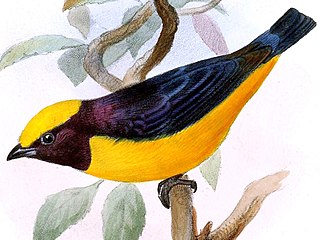
The orange-crowned euphonia is a species of bird in the family Fringillidae.
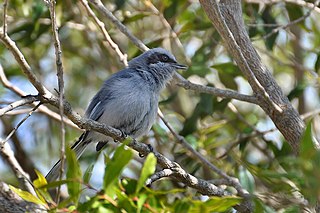
The masked gnatcatcher is a small songbird in the family Polioptilidae. It is found in Argentina, Bolivia, Brazil, Paraguay, and Uruguay.
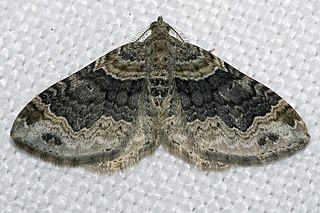
Xanthorhoe ferrugata, the dark-barred twin-spot carpet, is a moth of the genus Xanthorhoe in the family Geometridae. It was first described by Carl Alexander Clerck in 1759 and has a Holarctic distribution.
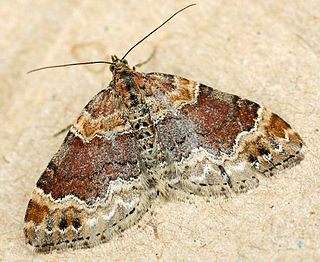
Xanthorhoe spadicearia, the red twin-spot carpet, is a moth of the genus Xanthorhoe in the family Geometridae. The species was first described by Michael Denis and Ignaz Schiffermüller in 1775.

Xanthorhoe designata, the flame carpet, is a moth of the genus Xanthorhoe in the family Geometridae. The species was first described by Johann Siegfried Hufnagel in 1767.
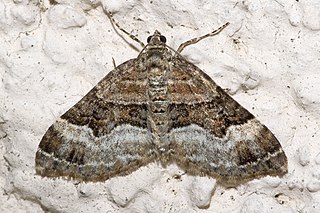
Xanthorhoe biriviata, the balsam carpet, is a moth of the genus Xanthorhoe in the family Geometridae. The species was first described by Moritz Balthasar Borkhausen in 1794. It is found "widespread in Europe and temperate Asia. In southern Europe the distribution is restricted only locally to the mountain(s)."

Xanthorhoe is a genus of moths of the family Geometridae described by Jacob Hübner in 1825.
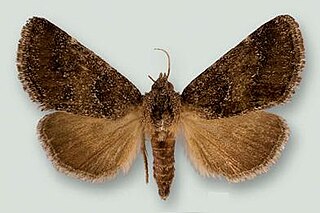
Schinia saturata, the brown flower moth, is a moth of the family Noctuidae. The species was first described by Augustus Radcliffe Grote in 1874. It is found in the United States from south Texas to South Dakota, southeast Arizona and from Florida to South Carolina.

Xanthorhoe decoloraria, the red carpet, is a moth of the family Geometridae. The species was first described by Eugenius Johann Christoph Esper in 1806 and it is found in northern Europe, to the east across the Palearctic to Siberia and the north of North America; further south it seems to occur chiefly, if not exclusively, in the mountains.
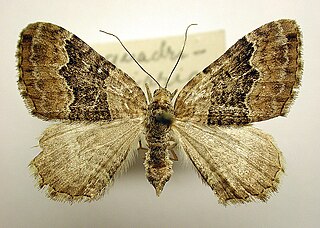
Xanthorhoe quadrifasiata, the large twin-spot carpet, is a moth of the family Geometridae. It is found in most of Europe, east to the Near East and the eastern part of the Palearctic realm.

Xanthorhoe abrasaria is a moth of the family Geometridae first described by Gottlieb August Wilhelm Herrich-Schäffer in 1856. It is found in the northern part of the Palearctic realm and the Nearctic realm.

Abisara saturata is a butterfly in the family Riodinidae. It is found in the Indomalayan realm.

The Javan woodcock or rufous woodcock is a small wader restricted to wet mountain forests on Sumatra and western Java. It nests on a bed of moss in light undergrowth. It has a "roding" display flight like Eurasian woodcock, but the calls are different.

Xanthorhoe alticolata is a species of moth in the family Geometridae first described by William Barnes and James Halliday McDunnough in 1916. It is found in North America.
Xanthorhoe iduata is a species of geometrid moth in the family Geometridae. It is found in North America.

Xanthorhoe fossaria is a species of geometrid moth in the family Geometridae. It is found in North America.
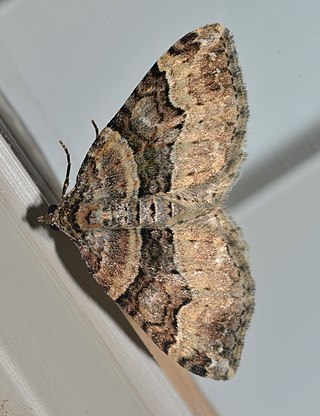
Xanthorhoe lacustrata, the toothed brown carpet moth, is a species of geometrid moth in the family Geometridae. It is found in North America.
Lasiolopha saturata is a moth of the family Nolidae first described by Francis Walker in 1865. It is found in Oriental tropics of India, Sri Lanka, Thailand, New Guinea and Australia.


















